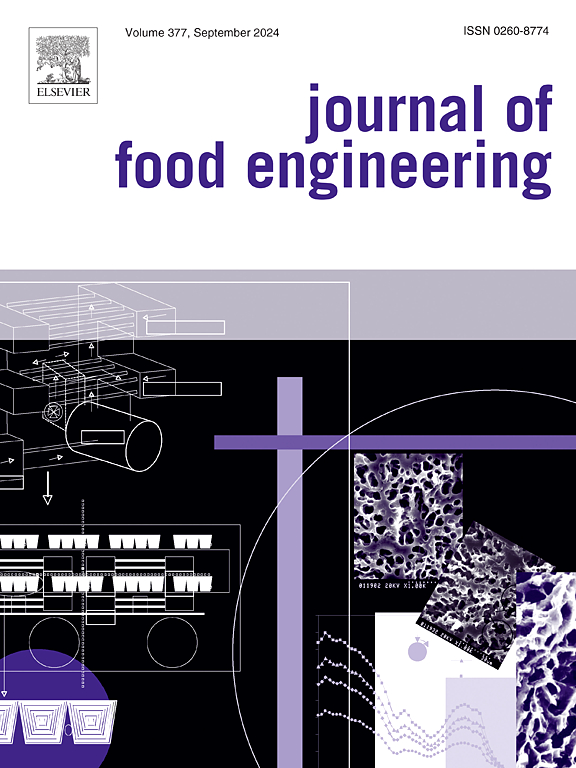Modelling of moisture content during baking of beetroot slices via Fick's law: A comparison of constant and variable effective diffusivity
IF 5.8
2区 农林科学
Q1 ENGINEERING, CHEMICAL
引用次数: 0
Abstract
During baking of vegetables, water migration is governed by both internal and external diffusion mechanisms that define the baking kinetics. Accurately describing this process requires diffusion models capable of reflecting changes in effective diffusivity. The objective of this study was to model the mass transfer during the baking of beetroot slices with Fick's law of diffusion, using constant and variable effective diffusivity. Baking kinetics of beetroot slices were analysed at 110, 120, and 130 °C. The mass transfer coefficient, kY; critical and equilibrium moisture concentrations (Cc, C∞) ranged from 1.91 to 2.10 kg water/m2sΔY, 4.22–5.36 kg water/kg d.s., and 0.10–0.11 kg water/kg d.s., respectively, indicating a faster water movement with temperature. Fick's law of diffusion was used to obtain the average moisture concentration, using the methods of slopes-by-subperiods (MSS) and successive approximations (MSA), considering a constant effective diffusivity, as well as a quadratic function of time (QFT) and Weibull distribution models, presuming a variable effective diffusivity. Diffusivity modelling showed that MSS is inadequate for accurately capturing moisture transfer during the falling-rate period. Its limited accuracy stems from the oversimplified assumption of constant diffusivity throughout the baking process of beetroot slices. In contrast, variable diffusivity models, including the QFT model and the Weibull distribution model, provided satisfactory fits to experimental data on average water concentration. These models contribute to a better understanding of water migration within the food, offering valuable insights into water mobility during food processing.
用菲克定律模拟甜菜根片烘烤过程中的水分含量:恒定和可变有效扩散系数的比较
在蔬菜的烘烤过程中,水分的迁移受到内部和外部扩散机制的控制,这些扩散机制决定了烘烤动力学。准确地描述这一过程需要能够反映有效扩散率变化的扩散模型。本研究的目的是用菲克扩散定律来模拟甜菜根片在烘烤过程中的传质,使用恒定和可变的有效扩散系数。分析了甜菜根切片在110、120和130℃下的烘烤动力学。传质系数kY;临界和平衡水分浓度(Cc, C∞)分别为1.91 ~ 2.10 kg water/m2sΔY、4.22 ~ 5.36 kg water/kg d.s和0.10 ~ 0.11 kg water/kg d.s,表明水随温度的变化更快。采用菲克扩散定律,采用坡次周期法(MSS)和逐次逼近法(MSA),考虑恒定的有效扩散系数,以及二次时间函数(QFT)和威布尔分布模型(假设有效扩散系数为变量),获得平均水分浓度。扩散率模型表明,MSS不足以准确捕捉下降速率期间的水分转移。其有限的准确性源于过于简化的假设,即在整个甜菜根片的烘烤过程中恒定的扩散率。而变扩散率模型(包括QFT模型和威布尔分布模型)对平均水浓度的拟合效果较好。这些模型有助于更好地理解食物中的水分迁移,为食品加工过程中的水分流动提供有价值的见解。
本文章由计算机程序翻译,如有差异,请以英文原文为准。
求助全文
约1分钟内获得全文
求助全文
来源期刊

Journal of Food Engineering
工程技术-工程:化工
CiteScore
11.80
自引率
5.50%
发文量
275
审稿时长
24 days
期刊介绍:
The journal publishes original research and review papers on any subject at the interface between food and engineering, particularly those of relevance to industry, including:
Engineering properties of foods, food physics and physical chemistry; processing, measurement, control, packaging, storage and distribution; engineering aspects of the design and production of novel foods and of food service and catering; design and operation of food processes, plant and equipment; economics of food engineering, including the economics of alternative processes.
Accounts of food engineering achievements are of particular value.
 求助内容:
求助内容: 应助结果提醒方式:
应助结果提醒方式:


